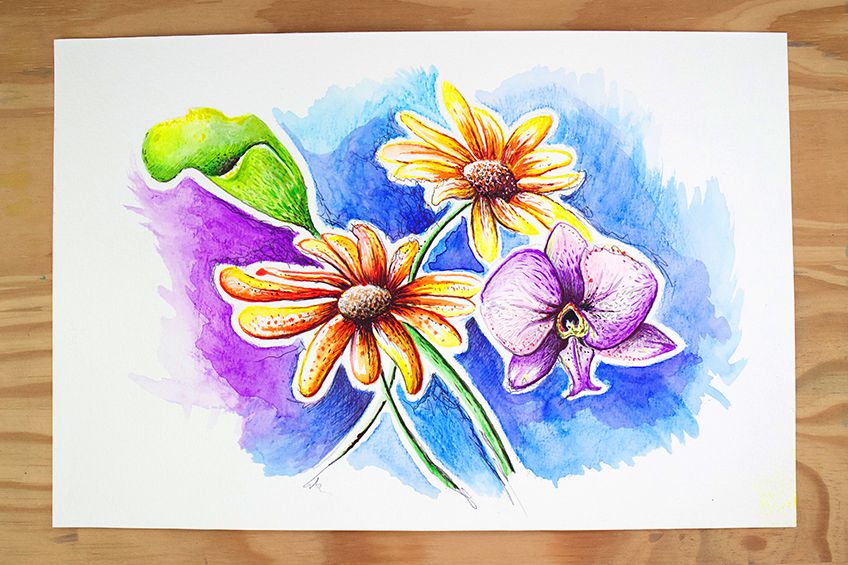How to Use Watercolor Pencils – Your Guide to Watercolor Pencil Art
Firstly, what are watercolor pencils? These are pencils that are water-soluble which means the pigment responds to water and can be activated by water. Using a watercolor pencil is a very unique medium that sits in between both watercolor painting and drawing. Most watercolor pencil art that you may have come across was achieved through a variety of techniques. A watercolor pencil drawing has quite a range of possible mark-making processes. In this tutorial, you will learn how to draw/paint flowers with watercolor pencils. We will go through a variety of techniques throughout our drawing, helping you gain more confidence in your watercolor pencil skills.
Before We Start
This tutorial intends to explore various techniques of watercolor pencil art. We will look at various methods for using this type of pencils through a drawing of easy watercolor flowers. Using watercolor pencils to draw watercolor flowers requires a more relaxed approach. Try to make sure you have time and a comfortable environment when doing this tutorial. We will be going through several techniques and then applying them to a watercolor flower painting and drawing.

Learning how to use watercolor pencils is not just a process of drawing flowers, but it is also a process of painting watercolor flowers. We will be learning how to paint watercolor flowers with our watercolor pencils as well as learning a variety of techniques throughout the process.
Necessary Materials
Having the correct material for learning how to paint watercolor flowers with watercolor pencils is essential to the best results. When learning how to paint flowers with watercolor pencils as a beginner means that we do not need the top range materials, however, we do need the correct materials. Below is a list of a few suggested items that you can purchase online. Here is what you will need:
If you are interested in the different types of pencils for watercolor and what to look for, you can also visit our best watercolor pencil blog post.
Preparation
What we want to do is make sure we have a flat surface and good lighting for this tutorial. It is helpful to always be in a quiet space, so perhaps try to place yourself somewhere where you may not be distracted. We want to make sure we have a jar of water nearby as it will be essential for this tutorial.
Lastly, We will be drawing a series of different flowers from a source image that you can either print or draw directly from your smart device.
A Step-by-Step Guide on How to Draw Flowers with Watercolor Pencils
Learning how to paint flowers with watercolor pencils is a great task for learning how to use watercolor pencils in general. The process is quite simple, whereby we will make some loose sketches of a variety of flowers. We then follow up that process with the painting of the flowers. Flowers allow us a great deal of freedom with our mark-making because of their abstract nature. This means we can be quite playful with the marks we make with our pencils when creating flowers in watercolor pencils. However, we will find that there are a variety of ways that we can both draw and paint with watercolor pencils. With that said, let us get started.
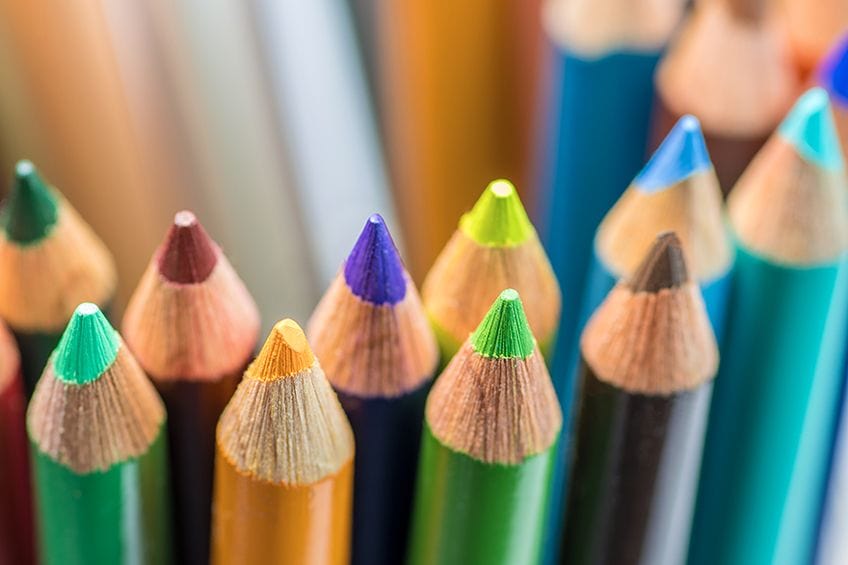
Step 1: Sketching Our Image
All watercolor pencil drawings begin with a pencil sketch. What we want to do is look closely at our source images and notice the various flowers that we want to use. In this tutorial, we will be drawing/painting a combination of daisies, orchids, and lilies.
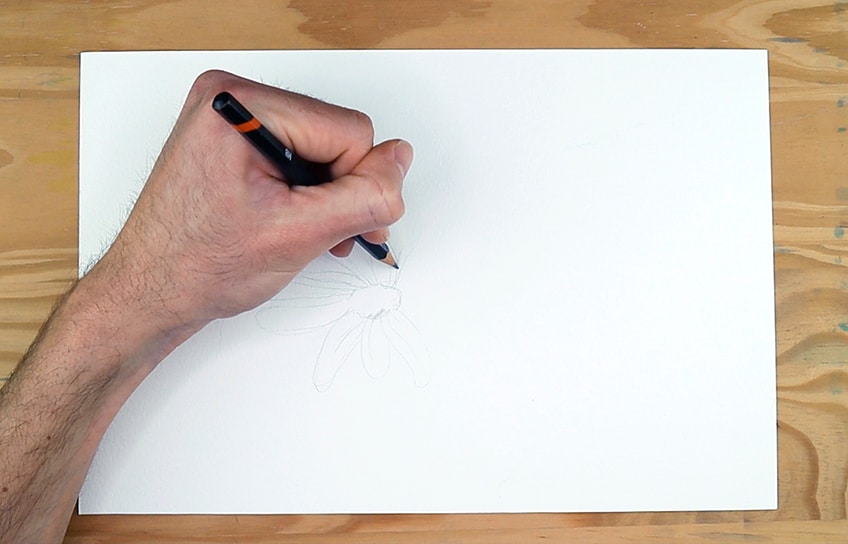
This tutorial is specifically aimed at helping us understand various techniques through the process of drawing some flowers. So don’t worry too much about flowers being perfect. On the contrary, keeping your drawing loose works well with the watercolor pencil medium.
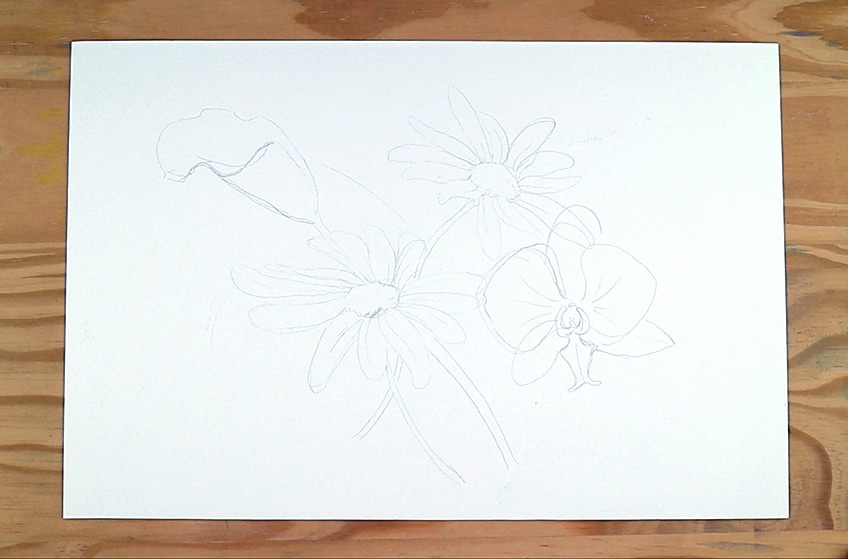
Step 2: Creating the Background
Because watercolor pencils are not the same as normal pencils, we want to apply the same process of watercolor painting to our drawing. By this what is meant is that we will build up the image by various grounds, starting with the background.
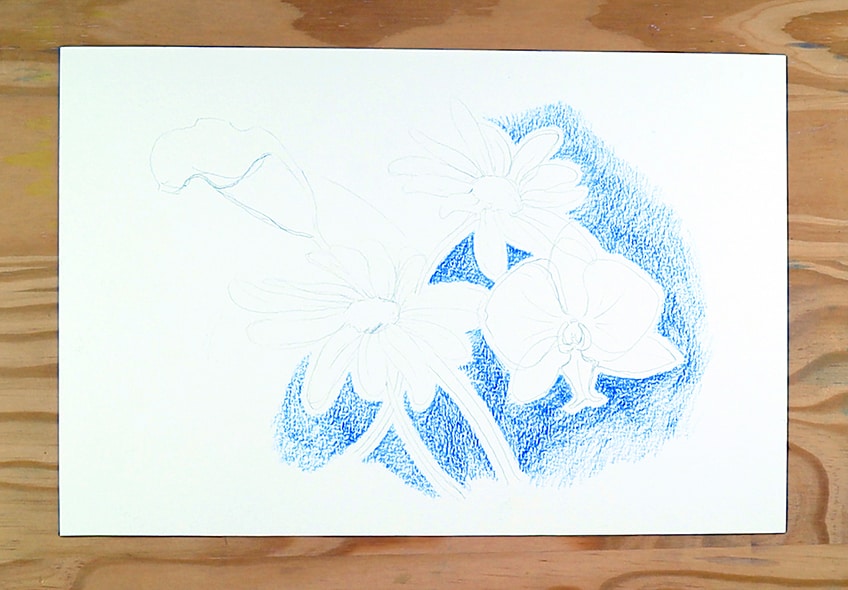
Let’s create an interesting color combination for our background by using a combination of blue and purple. Starting with your blue pencil begin to color around the sketch of your flowers. Leave a little space between the edges of your sketch and our background.

Leaving a little space between our sketch and the watercolor pencil will create a nice pop towards the end of the tutorial, allowing the flowers to have a beautiful contrast to that of the background. With your purple pencil begin to color the background around the pencil sketch, creating an interesting color combination in the background.

Once we have put some colors around our sketch, which will represent the background, we can now activate it with some water and a paintbrush. This is a more common way of using watercolor pencils, whereby the color is drawn with pencil and then activated with water and brush thereafter. Lightly wet your brush and begin to stroke the watered brush over your color pencil.

We will do this until we have gone over all of the colors of the background. We want to work very steadily as we make these strokes with our brush. A good suggestion is to start from one side of your drawing/painting and slowly move through the whole image until you have painted water over all the colors.
Once we have done that, allow it to dry for 10 minutes or so.
Step 3: Drawing and Painting The Orchid
Since we have four flowers, let us begin with one at a time, starting with the orchid. Orchids are very interesting flowers, in some ways their shape can make them seem creature-like. Let’s start with coloring in the petals by using pink for the larger surface area and purple for the edges.

We will be using a few techniques starting with the fading technique whereby you use two colors and slowly merge them with water. We do this by coloring the edges of our petals with purple and the body of the petals with pink.

This technique can also be understood through a tutorial on watercolor pencil techniques here: insert link to watercolor pencil techniques However, you should always leave a slight space between the two colors so that when we use water and a brush we can then pull them together with painterly strokes. You can place two couples in various ways on the flower as long as you leave slight space between them.

Once we have colored in our flower we can begin activating the colors with water. What we want to do is slowly begin to paint over our colors with a small watered brush. Slowly and steadily we will paint over the colors and begin making strokes from one into the other. Once that has dried we can begin to layer new marks on our flower, giving it various features. Another great technique we can use to make new marks is the palette technique. What we do is make a little scribble of watercolor pencil on a scrap piece of paper and then activate it with a watered brush.
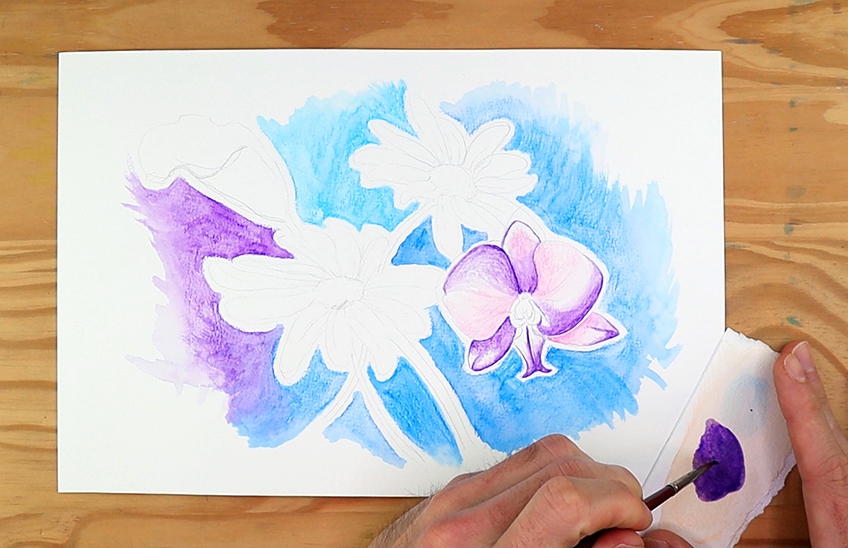
Regarding our source image, this technique is a great way to achieve various features in the flower. What this allows for is a variety of marks that will make our drawing/painting a bit more complex and less singular in its features.
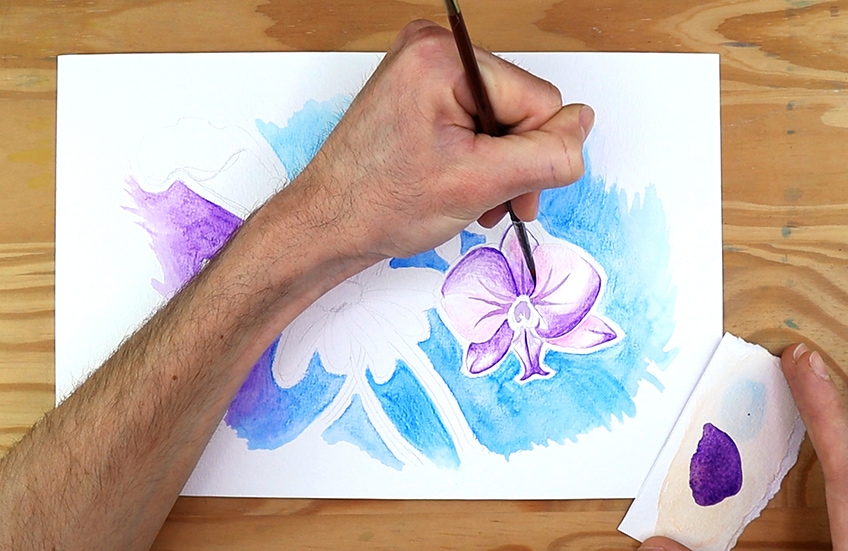
We can use various colors with this technique as long as we have waited for the previous marks to dry. This painting technique provides a great way of making shadows and watercolor effects on the drawing. At this point, we can begin to use various colors.
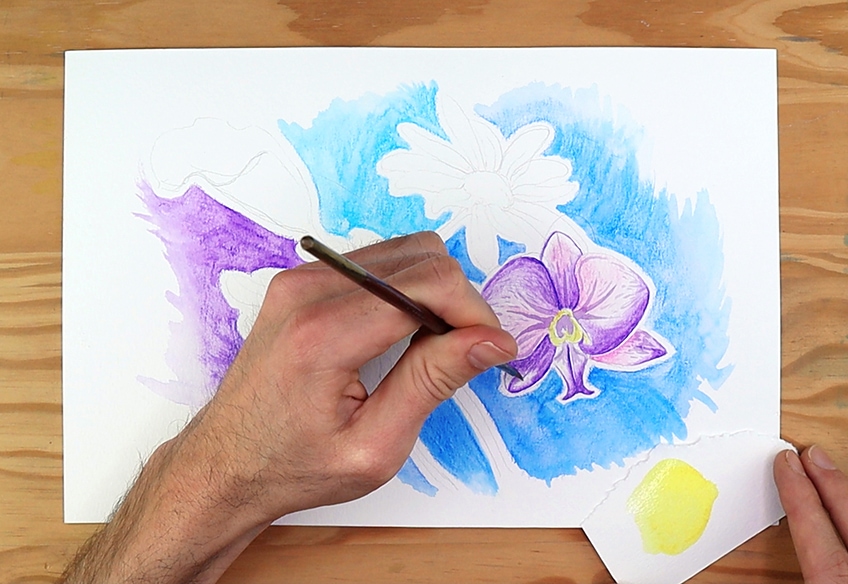
Once you have allowed your last application of watercolor pencil to dry, a good suggestion is to then make some stark contrast by using black as a way to define moments in the flower. With the same palette technique, water the black color and begin to paint some darker details. This can be done along the edges of the petals, it could be various lines in the bud or center of the flower, as well as various little lines or dots to give your flower a unique look. We can also do this with other darker colors such as purple or dark blue.

Once we have allowed our flower and its various layers of application to dry it should look quite interesting with a variety of marks. These are a few suggested colors in this tutorial, however, you can follow the general principles and apply your colors that you may find interesting.
Step 4: Drawing and Painting the Daisy
As we move on to a new flower let us begin with a new color and the classic watercolor pencil technique. We can begin by coloring in the petals yellow, However, try to not color in the whole petal but rather leave some negative space. Perhaps color on one side of each of the petals. Carry on this process until you have colored in all the petals. Another good suggestion is to color the base of the petals where they are connected to the center of the flower. What we will be exploring is the mixing technique whereby we draw colors onto each other before activating them with water.
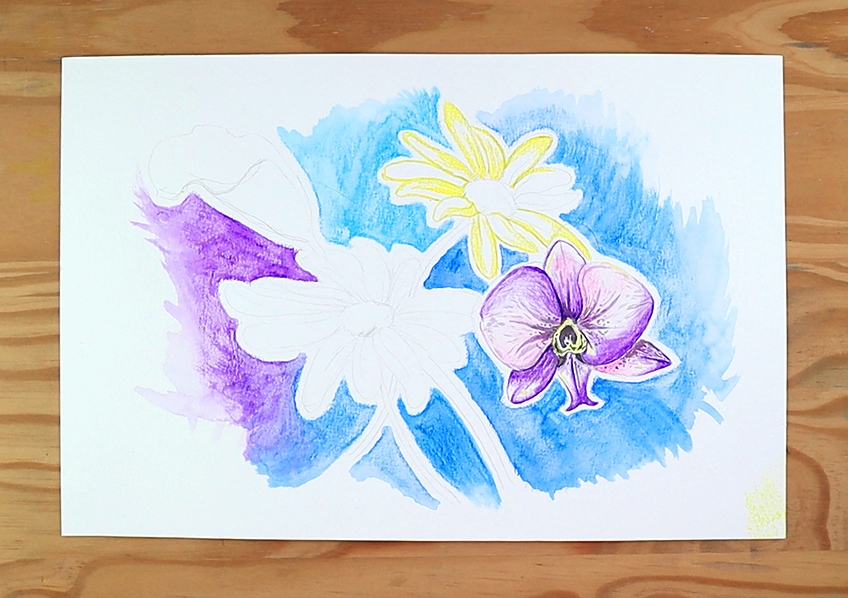
We can now take our orange, since it works well with yellow, and begin to color on top of our yellow. Again, we don’t want to color over the yellow completely, rather what we want to do is color only moments in each petal.

Once we have attended to all the petals with our colors, we can take a small thin brush, dip it in some water and begin to activate the pencil marks. We want to be very slow and steady with this process, working our strokes in line with the shapes of the petals. This is another great way of creating an interesting color variety. Once that has dried we can begin to add details on top of that layer. Again, the watercolor pencil is similar to watercolor paint in that they both are about layering. We can do this with a new technique, where we take a color pencil, let’s say brown, and begin to pull the pigment directly from the pencil with a watered brush.
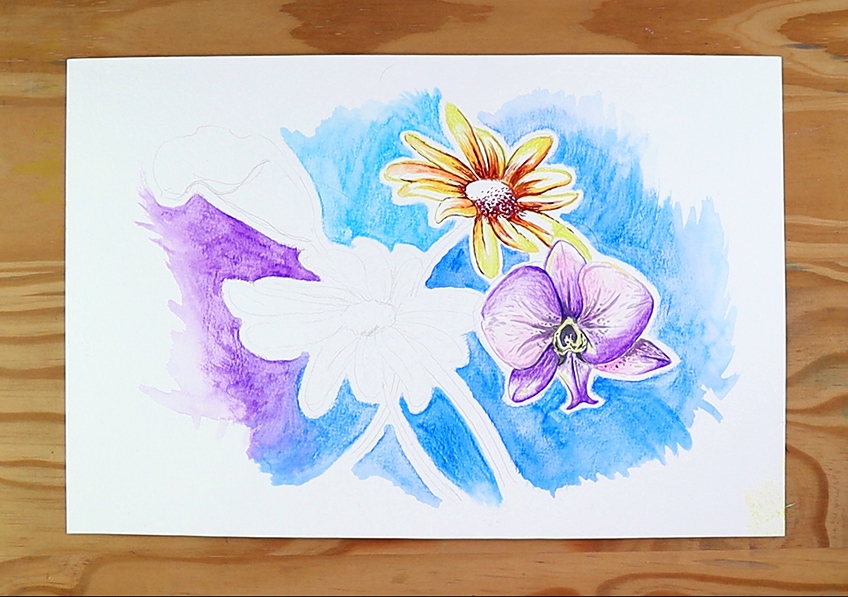
Again, since we want to make our details resemble the quality of a flower, consider where you paint these darker marks. Perhaps keep the dark moment near the base of each petal. Try to not wet your brush too much before pulling paint directly off the pencil. As you dip your brush in water, give it a little dab on some material to take some water away. Keep using this technique to create interesting marks in the flower.
It’s good to try various ways of applying colors in a watercolor pencil drawing, this way we learn various ways of making marks in an artwork. Try to attend to all the petals until you feel satisfied.
Once we have allowed the petals to dry, with the same technique, let us paint the center of the daisy with our brown pencil. Remember that the center of a flower is never flat and generally consists of little buds of pollen, so perhaps use a stippling process of applying your pencil marks. Once that has dried We can then add new darker tones on our flower with the same technique. Perhaps use black to create good contrast on the center of the flower. Try to put more color on one side of the center part of the flower to give the effect shadow.

To create some depth and shadow in the petals we can apply some slight dark strokes to the petals as well. However, make note of the center of the flower as a way to guide your understanding of the direction from where the light would be coming from. Painting watercolor flowers with watercolor pencil is about the exploration of mark-making.
Try to be subtle with some of your marks. We want to be subtle with mediums that are applied with painterly motions as they can be way too much if not attended to with caution and a steady hand. This is a general rule to work around as you go.
Step 5: Drawing and Painting Our Second Daisy
Let us begin to explore some new techniques whilst working with some that we have now familiarised ourselves with. Perhaps do some more classical coloring techniques on some of the petals. However, on some of the other petals, we can now try a new technique where we apply water onto the page which we will then color over with our watercolor pencil.
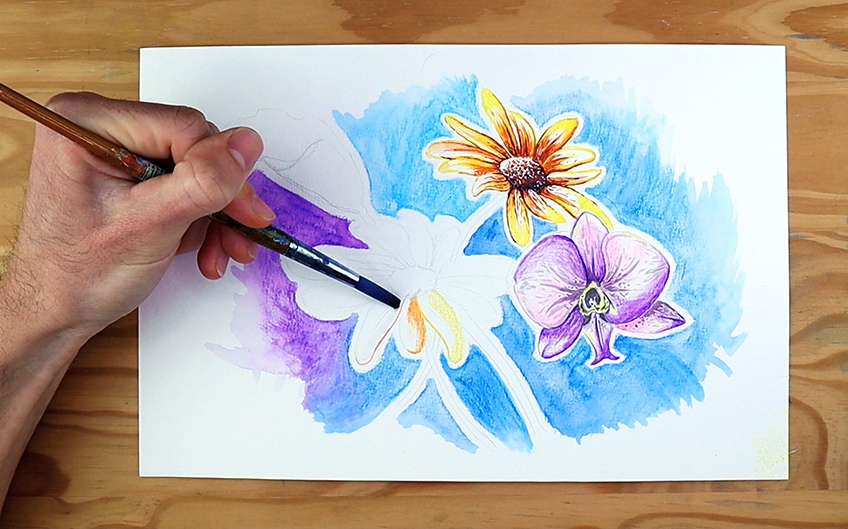
Try to cautiously apply the water onto the areas of the petals that you will try this new technique on. Whilst the page is still wet take a pencil, whichever color you want, and begin to slowly make drawing marks directly over the watered areas onto the petals. As you apply water onto more petals, a good suggestion is to not color the entire petal directly on the water. Rather, try to use this technique as a way of creating drawing marks that will describe the areas where the darkest tones will be.
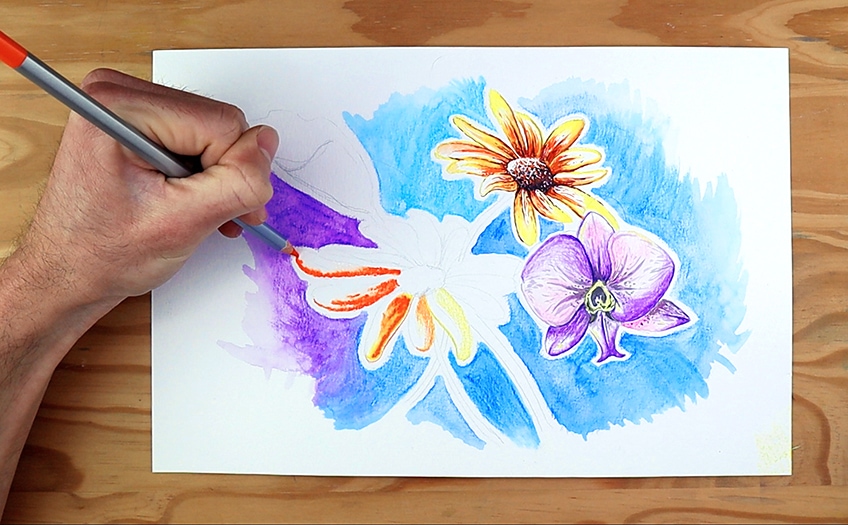
As you go through the petals you can add a variety of colors on top of each other directly over the watered areas. This is a great way to create contrast as it will provide a stark layer that can be painted and drawn over in later stages of drawing this flower. Once these marks are completely dry, let us use some other techniques that we’re familiar with. Again, let us use our pencil as a way of extracting pigment with our paintbrush. Because this technique also can provide stark marks, be cautious as you make interesting details.

Once these marks are completely dry we can now start trying some of the other techniques we know to add more details and effects in the flower. Perhaps, let us add some lighter tones with the same technique whereby we use the pencil directly for extracting color.
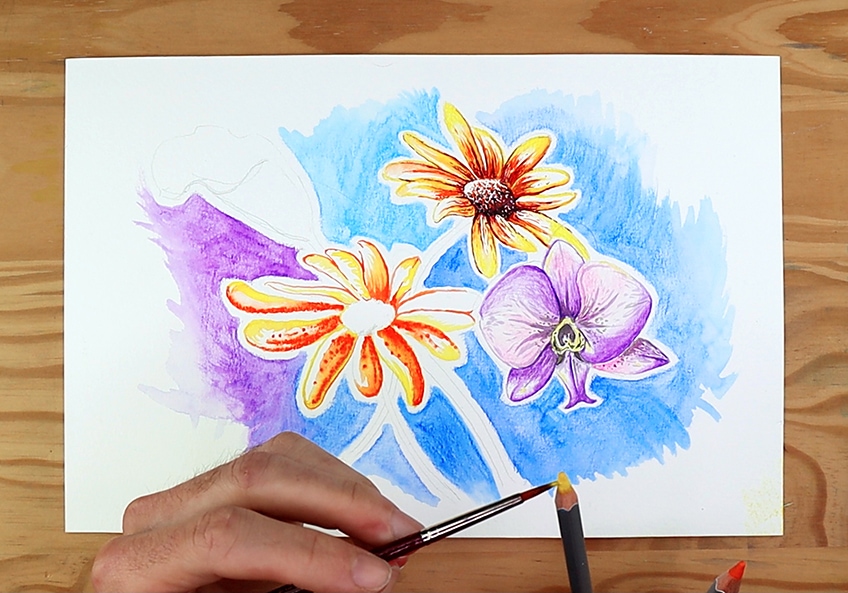
Using the technique, where we use the pencil as a direct source for extracting color, is such a convenient and fun way of applying painting-styled marks that work well with the pencil marks. Once we let that dry completely we should be left with a light-toned flower that has a variety of marks within the petals. Generally, it’s safer to apply lighter marks first but, again, there is no right way. It all depends on the effect you want and how wisely you go about achieving it.
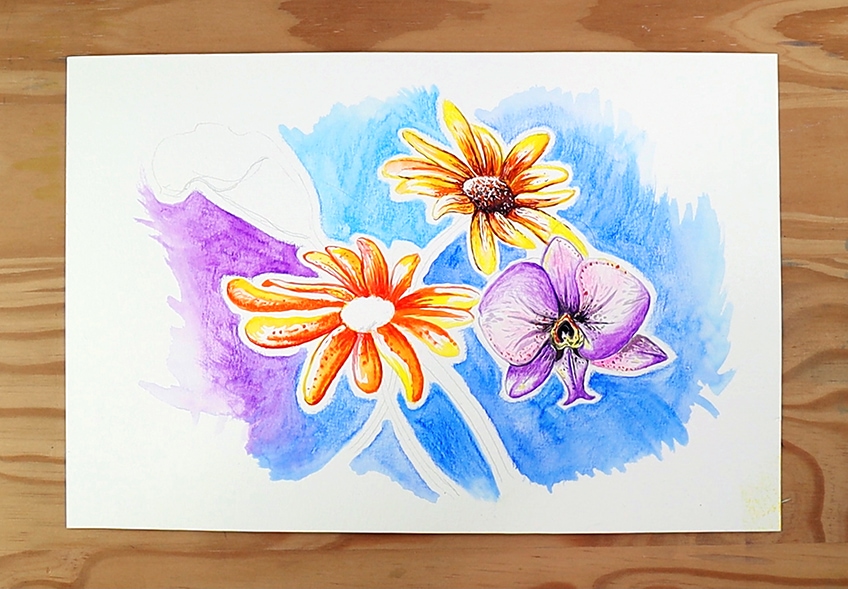
Once that has completely dried we can begin to add our darker marks in the bud of the flower as well as the petals. For the darker marks, allow yourself to try the variety of techniques we have explored thus far. Also, remember to consider the direction of light when creating shadowy effects.
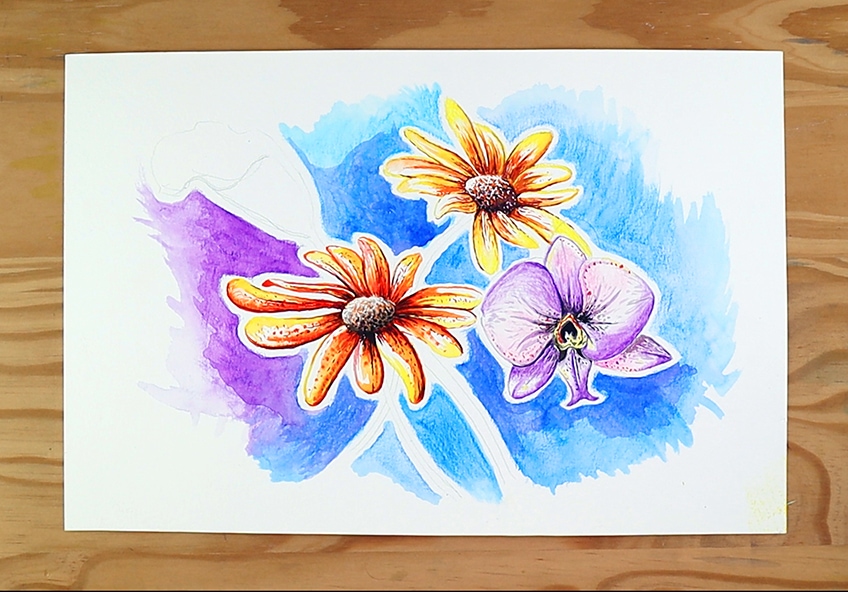
Step 6: Drawing and Painting The Lily
Let us move onto our last flower by using the merging technique, where we apply colors in close vicinity to one another which will then be integrated by the use of water. Let’s start by coloring our lily with two colors, perhaps green and yellow. We can then proceed to activate these colors with our paintbrushes and water by painting water directly over our pencil marks. We can also move the color around the flower which means you don’t need to always completely color in an area. The water will move the color around as you make paint strokes.
Again, let us use the variety of techniques learned until this point. For instance let us try the palette technique, whereby we scribble some color onto a scrap piece of paper and then mix it with water and a paintbrush to make a sort of paint that we can then use on our flower.
We can also use the technique where we pull paint directly from the pencil with a watered paintbrush to create darker tones in the center of our Lilly. We can also add in the colors for the stems of the flowers. Perhaps, use green, and once that has dried apply black along the edge to give it some definition.
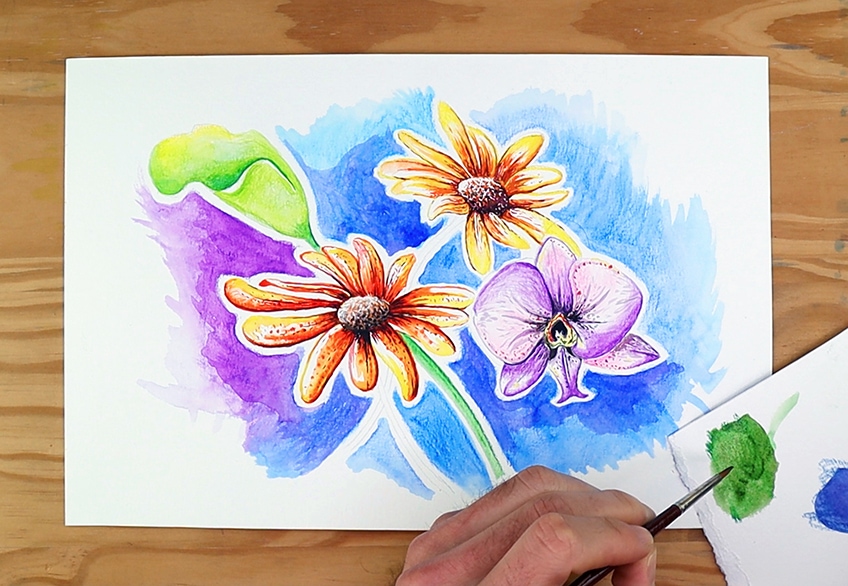
This exercise aims to give you insight into the variety of applications that you might be able to use within a watercolor pencil painting/drawing. At this stage feel free to try various techniques as you continue to make marks on the lily.
Step 7: Pen Work and Final Touch-Ups
Some techniques within watercolor pencil and paint are not always the medium itself. For one, Once your drawing has completely dried, a great technique to apply to your drawing/painting is using a pen to create interesting moments. In this case. perhaps try to do some scribbling effects around and over your drawing to enhance certain areas. These pen marks can create a very abstract quality in the work if that is your intention.
Or you can be more clinical about drawing some details with your pen, to create more realistic moments and more tones that resemble the qualities of real flowers.
Lastly, you can always use some of the techniques to enhance the contrast of your background or to add some final details in the flowers. Some good suggestions are to revisit your flowers and see if you can add new interesting marks or apply some darker tones of the same color in your background to create more contrast. There you have it, a tutorial on how to draw/paint interesting flowers with watercolor pencils. Remember, there is no right or wrong way of how you use these pencils. However, there is a pearl of general wisdom associated with what kind of effect you want to achieve and how to do it with what kinds of techniques are available to you.
Tips to Remember
This watercolor pencil tutorial shows you various watercolor pencil drawing/painting techniques as well as an easy watercolor painting that you can use as a template for your own. Using watercolor pencil can be accompanied by various mediums that may help refine the artwork. Sometimes a way of doing an artwork should not be done exclusively with just a single medium. As you do your watercolor art, always remember to have fun!
- In this watercolor pencils tutorial, the aim is to free you from a singular way of using the medium. So always try to use a medium in more than one way.
- When using a watercolor pencil give your water a refill with clean water now and then.
- Watercolor pencil art is not always just watercolor pencils. Drawing on top of our paintings can enhance the work sometimes.
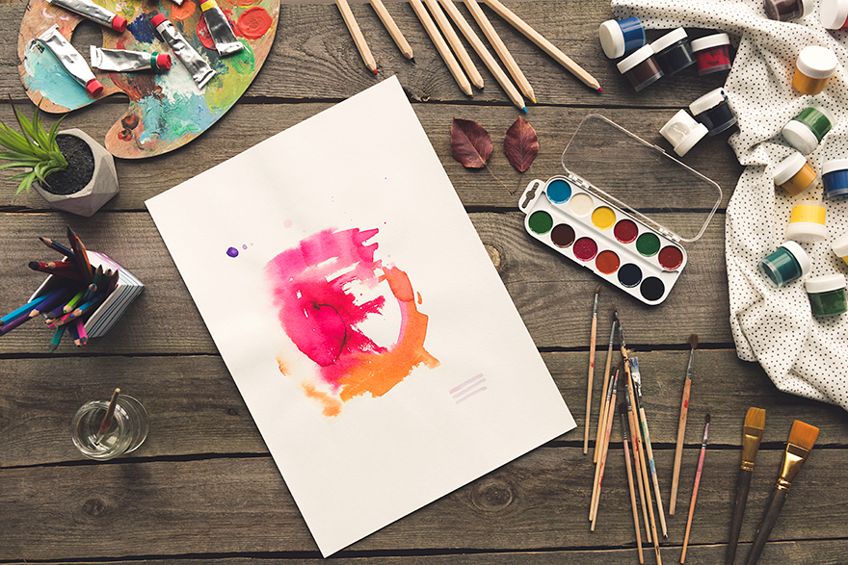
- Watercolor pencil drawing can come with inevitable mistakes. SO keep a paper towel on hand. If you want to redo a mark, wet the area and give it a dab with a paper towel.
- Doing a watercolor flower painting with watercolor pencils comes with the freedom to explore. Try using both drawing and painting approaches.
- This watercolor flower tutorial is about focusing on the various ways to use your pencils for both drawing and painterly effects. So feel free to try various techniques as you go through the tutorial.
There you have it! A tutorial on a few watercolor pencil tips and techniques to help you strengthen your watercolor pencil skills. Watercolor pencil art is a great way to create a watercolor flower painting. When learning how to use watercolor pencils we must also learn how to paint with watercolor pencils. Knowing how to paint watercolor flowers with watercolor pencils is about learning the variety of approaches one can use with this medium.
Frequently Asked Questions
How Do You Use Watercolor Pencils?
A good suggestion and a more common application are to draw directly onto the surface of a paper with your pencils and then activate the marks by painting over them with water. There is no one way to use watercolor pencils. In some instances, you can premix colors and make paint out of them and then use a brush to make painterly marks. Watercolor pencil drawings can also be made into a more painterly style with water and then once dry can be drawn over with other mediums. There are a variety of ways to use watercolor pencils, it’s all about trying to be as creative with the medium as you possibly can be.
Can Watercolor Pencils Be Used Without Water?
Yes, watercolor pencils do not always need to be activated with water. What makes an interesting image, in general, is when there is a variety of marks that create a diverse range of qualities. So when you do a watercolor pencil drawing you can use water or not or do both. There is no one way to learn how to paint with watercolor pencils, the trick is to be as creative with the medium as best as possible. As you practice your watercolor art you will see that, like any medium, there is always a variety of application methods. However, when learning how to paint watercolor flowers with watercolor pencil, you want to have the full range of mark-making possibilities that water can provide.
What Is Special About Watercolor Pencils?
Watercolor pencils are the unique medium that sits in between painting and drawing. What is particularly special about watercolor pencils is that it is a medium that frees someone to combine both paintings and drawing in a single artwork. However, it goes further than that by the way one can use the pencil as a painting medium which can often make unique qualities that can only be found in watercolor pencil drawings. It’s nice to mix pencil marks with painting marks when you want to paint watercolor flowers.
How to Paint Watercolor Flowers With Watercolor Pencils?
The best thing about learning how to paint watercolor flowers with watercolor pencils is that for one, there is a variety of application methods and secondly that comes with both drawing and painting qualities. However, it all starts with a general sketch of the flowers, from there you have free range to either make drawing marks or painting marks. Watercolor flowers with watercolor pencils are quite easy to paint as they are quite abstract in nature. This means the process of painting easy watercolor flowers can be developed through drawing unique marks or painting unique marks which can still resemble the qualities of a flower. This watercolor flower tutorial breaks down a few ways to explore those marks, however, there is no specific way to paint watercolor flowers. It’s all about experimentation.
Matthew Matthysen is an educated multidisciplinary artist and illustrator. He successfully completed his art degree at the University of Witwatersrand in South Africa, majoring in art history and contemporary drawing. The focus of his thesis was to explore the philosophical implications of the macro and micro-universe on the human experience. Matthew uses diverse media, such as written and hands-on components, to explore various approaches that are on the border between philosophy and science.
Matthew organized various exhibitions before and during his years as a student and is still passionate about doing so today. He currently works as a freelance artist and writer in various fields. He also has a permanent position at a renowned online gallery (ArtGazette) where he produces various works on commission. As a freelance artist, he creates several series and successfully sells them to galleries and collectors. He loves to use his work and skills in various fields of interest.
Matthew has been creating drawing and painting tutorials since the relaunch in 2020. Through his involvement with artincontext.org, he has been able to deepen his knowledge of various painting mediums. For example, watercolor techniques, calligraphy and lately digital drawing, which is becoming more and more popular.
Learn more about Matthew Matthysen and the Art in Context Team.
Cite this Article
Matthew, Matthysen, “How to Use Watercolor Pencils – Your Guide to Watercolor Pencil Art.” Art in Context. February 21, 2022. URL: https://artincontext.org/how-to-use-watercolor-pencils/
Matthysen, M. (2022, 21 February). How to Use Watercolor Pencils – Your Guide to Watercolor Pencil Art. Art in Context. https://artincontext.org/how-to-use-watercolor-pencils/
Matthysen, Matthew. “How to Use Watercolor Pencils – Your Guide to Watercolor Pencil Art.” Art in Context, February 21, 2022. https://artincontext.org/how-to-use-watercolor-pencils/.


